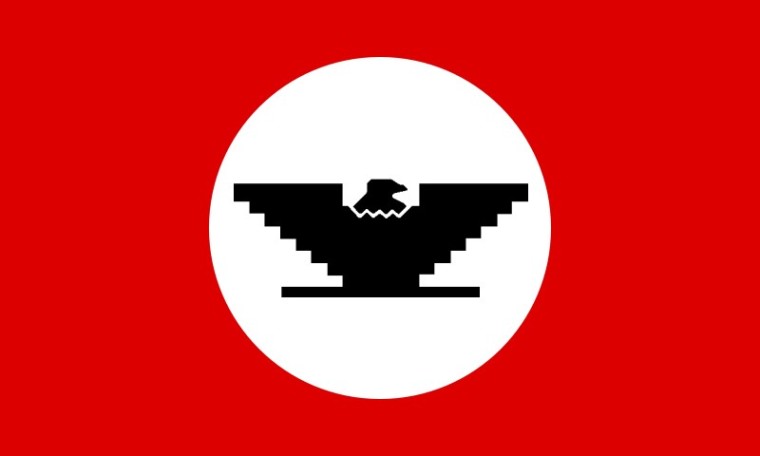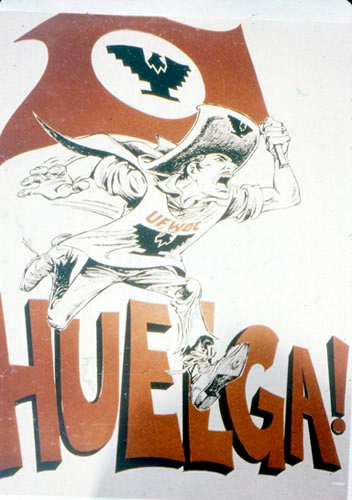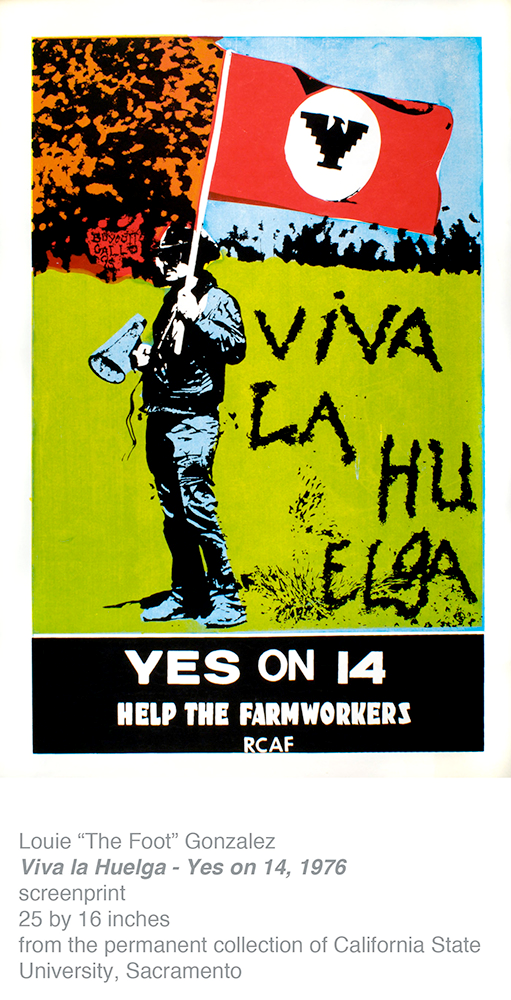For those of you who cannot access Microsoft Office Word, here is the outline. All of the information is here, just the formatting became completely messed up when copying and pasting. Sorry for the inconvenience of the poor formatting. Thank you!
- Introduction: The United Farm Workers of America is an association founded by César Chávez in 1962 whose mission is “to provide farm workers and other working people with the inspiration and tools to share in society’s bounty” (“Our Vision”). The main symbol of the association is their flag, on which is a black Aztec eagle. This flag appears in Huelga! by Andrew Zermeño and in Yes on 14 by Louie “The Foot” Gonzalez. Because both artworks included the flag, I had to ask myself, “How and why is the flag important in each image?” The flag is important in each image because it helps the images champion the strike and advocate for more rights.
- Background Information on the Flag
- Designed by Richard Chávez and César Chávez’s cousin Manuel
- They used an Aztec symbol because “many Mexican Americans identified with” the Aztecs (Fuentes)
- The symbol was a representation of their proud heritage
- Designed in such a way that it could be easily recreated by the workers on strike
- Staircase-like wings
- Red with a white circle, in the center of which was a black Aztec eagle

- The colors are significant because they symbolized how Chávez saw the life of a farm worker
- The black symbolizes the hardships that the workers were facing (Fuentes)
- The white symbolizes the hope for a better future (Fuentes)
iii. The red symbolizes all that the workers have been forced to sacrifice (Fuentes)
- The eagle
- Faces to the right looking towards the future
- There are no talons, thus symbolizing no harm
- There is a base, though, which symbolizes “peaceful stability” (Fuentes)
- Wings are shaped like indigenous temples (Fuentes)
- Andrew Zermeño “interpreted the wings as an inverted pyramid” (Fuentes)
- Fixed the eagle’s neck because it looked like a turkey’s neck (Fuentes)
- Created the poster Huelga!
- Huelga! by Andrew Zermeño (1965)

- “Huelga!” means “Strike!” in Spanish (Zermeño)
- Poster came out during the Delano Grape Strike
- The striker is a member of the United Farm Workers Organizing Committee
- UFWOC is angry at the growers
- The man’s brows are furrowed
- He is screaming
- Huelga is written in all capitals
- An exclamation point is used at the end of Huelga
- Justice is urgent
- The man on strike is running as seen through the lines behind him
- The man on strike is “leaping” over the injustices done unto him
- UFWOC is frustrated and demands justice now
- The entire poster is a symbol of pride
- The use of three Aztec eagles: on the flag, on the shirt, on the hat
- The use of only three colors: red, white, and black
- The same colors of the UFW flag
- The use of Spanish, the main language of the farm workers and the Chicanos, instead of English
- The striker is seen wearing a sombrero, not just a normal hat
- Shows that the farm workers are proud of their heritage and what they are fighting for
- Why must the flag be used?
- The striker is shown gripping the flag fiercely and proudly
- The man is proud to be on strike because he knows that if he continues, he
will gain the rights and respect he deserves, and thus the pride that the flag
symbolizes seeks to champion the farm workers’ strike
- Because of the man’s strong grip on the flag, Zermeño is showing that the workers will remain steadfast, so the growers have to meet their demands, and thus advocates for more rights, respect, and a better future, as a whole
- How does this image relate to the Chicano movement as a whole?
- The farm workers fighting for their rights is just one part of the Chicano movement
- Just like the UFWOC member in the poster, people in the Chicano movement were of Mexican heritage
- This poster is Chicano art because it is created by a Chicano person about issues relating to Chicanos: more respect, better pay, more recognition, etc.
- Yes on 14 by Louie “The Foot” Gonzalez (1976)

- Importance of Louie “The Foot” Gonzalez (“Luis C. Gonzalez”)
- Born in Mexico City, but raised in Sacramento
- Attended Sacramento State University
- Member of the Royal Chicano Air Force
- “Collective of activist Chicano artists” (“Luis C. Gonzalez”)
- Much of his work, including this piece, is centered around his “support for
the farm workers” (“Luis C. Gonzalez”)
- “Viva La Huelga” means “Long Live the Strike” in Spanish (Gonzalez)
- The phrase is clearly indicative of Gonzalez’s support of the strike
- The saying itself is significant because it was the official “battle cry”
of the farm workers’ movement
- The saying has been featured on other posters
- This poster both promotes the farm workers to strike and persuades others to not indulge in luxuries that cause others harm
- The many phrases
- “Boycott Gallo” (Gonzalez)
- References Gallo Wines
- In the background on the red-orange sign
- I interpreted this as the phrase is written on the blood and sweat
of the workers that Gallo Wines treats badly
- By doing this, he is letting others know of the horrors occurring
to the farm workers without verbally explaining the details
- By including this phrase, he is not only reminding the workers of the
horrors they face to keep their morale up to strike, but is also dissuading
others from buying Gallo Wines by showing the horrors that come in
producing them
- “Yes on 14” (Gonzalez)
- Proposition 14: Agricultural Labor Relations-Initiative Statute (Chavez)
- Was going to amend the Agricultural Labor Relations Act of
1975 (Chavez)
- Established collective bargaining (Chavez)
iii. Revised “the appointment process of members to the
Agricultural Labor Relations Board” (Chavez)
- Gave union workers more rights (Chavez)
- Allowed “farm workers to vote for or against union
representation through secret ballots” (Chavez)
- By including this phrase, he is not only reminding farm workers that
there is a way to gain more rights (through Proposition 14) if they
continue to strike, but is persuading others vote on that issue and “Help the
Farmworkers”
- “RCAF” (Gonzalez)
- Acronym for the Royal Chicano Air Force
- Makes it personal, and thus relatable, because Gonzalez is a member
- Giving the stamp of approval on the poster
- People in the poster
- Everyone is on the field, the place they work, thus showing that they are
standing their ground
- Important that they are on the field because their blood, sweat, and tears
go into making the grapes grow in the fields
- The people in the background are together, no individual can be
pinpointed
- Shows unity and strength in numbers
- The man in the foreground is holding a bullhorn
- Shows that the workers are not afraid to speak out against the injustices
that occur to them everyday
- They want the growers to know that they are loud and they are proud
- Why must the flag be used?
- The mass of people is united under the flag, physically and
emotionally
- Without the flag the way it is juxtaposed on the poster, it is difficult to
tell whether the masses are on strike or just watching the display
- The flag gives the masses of people the identity of a unified group of
strikers
- That unity that the flag symbolizes champions the strike
- Acknowledges that the strike is unifying the people
- With strength in numbers, anything can be accomplished
iii. The strikers’ united front cannot back down until the
rights they deserve are received, and thus advocates for a
better future
- The flag helps identify the man as a strong, confident leader
- The man’s attire is authoritative, like an overseer
- Looks like Mr. Sir from the movie Holes
- Farm owners were known to berate their workers and carry around
bullhorns to ensure that they did their work
- Without the flag, the man looks like a mean farm owner, instead of a
strike leader
- The man is actually a labor protestor named José Montoya (Chavez)
- How does the image relate to the Chicano movement as a whole?
- The use of RCAF
- The whole poster revolves around the farm workers’ strike, which was a
part of the Chicano movement
- The persuasion of boycotting organizations that denied respect and rights
- The poster is Chicano art because it is designed by a Chicano artist about
Chicano themes
- Conclusion: In Huelga! by Andrew Zermeño, the flag is a symbol of pride, while in Yes on 14 by Louie “The Foot” Gonzalez, the flag is a symbol of identity and unity. Although both images use the flag in different ways, they are able to accomplish the same goal of championing the strike and advocating for a better future. Neither image could have succeeded without the use of the flag.
- Discussion Questions
- What other ideas could a symbol, such as this flag, symbolize to the people it represents? Why is it important that it has these symbolisms?
- Earlier I mentioned that the flag has a black Aztec eagle on it. What is the significance of the black eagle to the farm workers as compared to the bald eagle of today?
Works Cited
Chavez, Ricardo. “Louie “The Foot” Gonzalez.” Selected Works from the Sacramento State Art
Collection. Ed. O’Brien, Elaine. California State University, Sacramento. 5-6. Web. 4 Apr. 2016. <http://www.csus.edu/indiv/o/obriene/Home%20page/
SelectedWorksfromtheSacramentoStateArtCollection.pdf>.
Gonzalez, Louie “The Foot.” Yes on 14. 1976. Silkscreen.
Fuentes, Ed. “How One Flag Went From Representing Farmworkers to Flying for the Entire
Latino Community.” Takepart. n.d. Web. 4 Apr. 2016. <http://www.takepart.com/article/
2014/04/02/cultural-history-ufw-flag>.
“Luis C. Gonzalez (aka Louie-the-Foot).” UC Santa Barbara Library. UC Santa Barbara, 2010.
Web. 4 Apr. 2016. <http://www.library.ucsb.edu/special-collections/cema/
louie_the_foot>.
“Our Vision.” United Farm Workers. ¡Si Se Puede!. The United Farm Workers. 2016. Web. 4
Apr. 2016. <http://www.ufw.org/_page.php?inc=about_vision.html&menu=about>.
Zermeño, Andrew. Huelga!. 1965.






